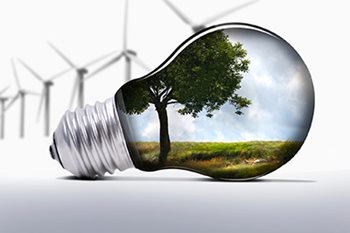28 May 2015
Energy concepts: Can renewable energy catch up with traditional methods of power generation?
By Kristen Gross
 In California, policy makers have set an aggressive goal to produce 33 percent of the state’s energy using renewable resources by 2020, and 50 percent by 2050. These include bio-fuels, and natural sources like wind, solar, tides, and geothermal. In a recent UC San Diego Extension workshop, experts from the energy sector, including James D. Broesch, Project Engineer, ROSYS; Joe Frani, P.E., Project Manager Resource Planning, SDG&E; and Hassan Ghoudjebaklou, Ph.D., P.E., Principal Engineer, Transmission Planning, SDG&E, presented both the technical challenges and proposed solutions in achieving this goal.
In California, policy makers have set an aggressive goal to produce 33 percent of the state’s energy using renewable resources by 2020, and 50 percent by 2050. These include bio-fuels, and natural sources like wind, solar, tides, and geothermal. In a recent UC San Diego Extension workshop, experts from the energy sector, including James D. Broesch, Project Engineer, ROSYS; Joe Frani, P.E., Project Manager Resource Planning, SDG&E; and Hassan Ghoudjebaklou, Ph.D., P.E., Principal Engineer, Transmission Planning, SDG&E, presented both the technical challenges and proposed solutions in achieving this goal.
Challenges:
Policies and Market
Currently, the energy market is designed in the traditional paradigm: power is generated at a facility (hydro, coal, natural gas or nuclear), delivered via transmission lines, and enjoyed in our homes and businesses. To this model, we’ve added a new twist. Net Energy Metering (NEM) allows customers to generate power at their homes, and gives them a credit for the power they add to the grid at the same rate as the power they take out. If they use more than they produce, they pay the difference. While it has been successful in popularizing renewable energy sources, it has also driven up rates because the majority of people who do not have solar panel systems at their homes take on an inordinate share of the costs of managing the power grid’s infrastructure. Electricity can be stored to a point at home using batteries and capacitors, but not practical in terms size. Also, energy produced by solar panel systems can’t be controlled, so we wind up with a system where the utility company purchases enough electricity for all, regardless of whether it is needed. In addition, switching to renewables would require a shift in financial resources; there is a cost to building and assembling wind turbines and solar panels that would be reflected in the rate. Wind turbines are especially more complex and labor intensive.
Technology
 It is difficult to predict the capacity of wind and solar. Solar power prediction and regional networks to distribute commercial production is a major present and future task. Additionally, SDG&E purchases energy; it does not produce it. So the challenge is to always buy the right amount. If too much it would be wasted, driving up rates. Too little, and the grid could suffer outages. The more power generation you don’t own and control, the more at-risk you are for outages. For a renewable system to work, the system would require transmission line upgrades. For example, the areas most optimal for wind farms are the farthest from load centers (cities), so a significant amount of transmission would need to be built and upgraded to service these areas. This also demands little loss in the path of transmission to the loads (users).
It is difficult to predict the capacity of wind and solar. Solar power prediction and regional networks to distribute commercial production is a major present and future task. Additionally, SDG&E purchases energy; it does not produce it. So the challenge is to always buy the right amount. If too much it would be wasted, driving up rates. Too little, and the grid could suffer outages. The more power generation you don’t own and control, the more at-risk you are for outages. For a renewable system to work, the system would require transmission line upgrades. For example, the areas most optimal for wind farms are the farthest from load centers (cities), so a significant amount of transmission would need to be built and upgraded to service these areas. This also demands little loss in the path of transmission to the loads (users).
Load Flow
Electricity will always seek to close the circuit, which makes it easy to predict. However with the new bi-directional flow caused by multiple generators, you have to consider the capacity of the wires. This complicates protection schemes and puts the system at risk for overload. Since we have no large scale, reliable way to store electricity, like we could water in a dam, generation must always match demand. Storage is the key to getting past the sporadic nature of natural energy sources. The challenge is that utilities can’t know exactly what independent generators (i.e. a homeowner with a solar panel) are doing, or have control over them.
Solutions:
 To overcome these challenges, we need to improve communications and coordination. Bringing all the energy players to the table to face these challenges together is step one. Helping the public understand is also important, and transparency for the consumer is critical. Next we need to implement technical modifications that address the challenges with good reliability solutions. Circuits need to be changed to support the bi-directional flow. And we need to devise ways to better respond to demand.
To overcome these challenges, we need to improve communications and coordination. Bringing all the energy players to the table to face these challenges together is step one. Helping the public understand is also important, and transparency for the consumer is critical. Next we need to implement technical modifications that address the challenges with good reliability solutions. Circuits need to be changed to support the bi-directional flow. And we need to devise ways to better respond to demand.
For example, the pumped-storage hydroelectricity model, in which energy is stored in the form of gravitational potential energy of water, pumped from a lower reservoir to a higher one. During periods of high demand, the water is released through turbines to produce electric power. Another example is batteries, and with the growing popularity of electric vehicles, we continue to innovate with this technology. In 2013, Duke Energy completed the Notrees Battery Storage Project, creating a battery that can store 36 Megawatts of the 153 Megawatt potential generation capacity at the Notrees Wind Farm in Texas.
Finally, to keep up with the changing landscape and increased energy producers, we need to examine regulatory and standards changes to help pave the way for this paradigm shift.
By the end of the presentation, all had agreed that it is possible to bridge the gap between renewable energy production and traditional generation. However it comes at a price — can we afford to achieve the goal of “30 percent by 2020”? Can we afford not to?
To be a part of the solution and help California reach its goal, consider UC San Diego Extension’s new Power Systems Engineering Specialized Certificate. Learn more by visiting http://extension.ucsd.edu/powersystems.